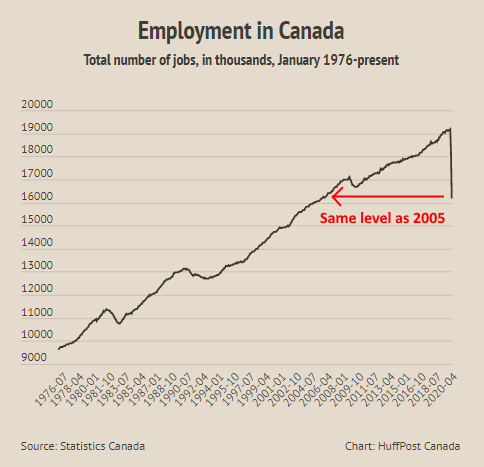MONTREAL ― Canada’s unemployment rate hit 13 per cent in April as the country shed 2 million jobs, Statistics Canada reported on Friday.
That was actually not as bad as the experts had been predicting. The median prediction of economists polled by Bloomberg was for a loss of 4.4 million jobs.
Still, with the total number of jobs coming in at 16.2 million in April, the country effectively erased all its job gains going back to the spring of 2005, in just two months.

But the real job loss situation appears to be much worse than the numbers suggest.
More than 1.1 million people left the labour force in April, telling Statistics Canada they aren’t searching for work. Had those people been included in the unemployment statistics, Canada’s jobless rate would be 17.8 per cent.
The data shows that barely more than half of working-age Canadians currently have a job. The employment rate fell to 52.1 per cent, the lowest in records going back to 1976.
In all of the Atlantic provinces except Prince Edward Island, fewer than half of people aged 15 and over had a job in April.
On top of the job losses, another 2.5 million Canadians worked less than half their usual hours in April, Statistics Canada said.
The agency described the job losses as “unprecedented.”
“One in seven. That’s roughly how many Canadians lost their job on net since February,” TD Bank senior economist Brian DePratto wrote in a client note Friday morning.
“One in four is how many either lost their job, or most/all of their hours. The scale of the needed pandemic response has been such that odds are that most of us know at least one, if not several people who’ve had their lives disrupted as a result.
“We have to go back to the Great Depression to find similar numbers, and even then the speed at which the current episode unfolded seems to have no identifiable precedent.”
Broken down regionally, Quebec saw the sharpest spike in joblessness, losing 778,000 jobs in a month. Its jobless rate spiked to 17 per cent, the highest in the country. It was 8.1 per cent the month before.
Quebec shut down more of its economy than other provinces, including housing construction, which was declared an essential service everywhere else and only resumed in Quebec on April 20.
Ontario lost 959,000 jobs, and its jobless rate jumped to 11.6 per cent, from 7.6 per cent the month before.
Proportionally, that was similar to British Columbia, which lost 421,000 jobs. Its jobless rate jumped to 11.5 per cent, from 7.2 per cent.
Alberta lost 382,000 jobs, and its jobless rate jumped to 13.4 per cent from 8.7 per cent the month before.
The situation looks similar to the one in the U.S., where the unemployment rate jumped to 14.7 per cent in April, according to data from the Bureau of Labor Statistics released on Friday.
The U.S. lost 20.5 million jobs in April, a similar scale of loss to Canada when adjusted for the size of the two countries’ labour forces.
Unemployment rates by province (previous month in brackets)
Newfoundland and Labrador - 16.0 (11.7)
Prince Edward Island - 10.8 (8.6)
Nova Scotia - 12.0 (9.0)
New Brunswick - 13.2 (8.8)
Quebec - 17.0 (8.1)
Ontario - 11.3 (7.6)
Manitoba - 11.4 (6.4)
Saskatchewan - 11.3 (7.3)
Alberta - 13.4 (8.7)
British Columbia - 11.5 (7.2)
(Table compiled by The Canadian Press)